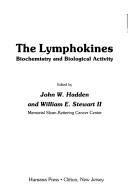| Listing 1 - 10 of 181 | << page >> |
Sort by
|
Dissertation
Year: 1974
Abstract | Keywords | Export | Availability | Bookmark
 Loading...
Loading...Choose an application
- Reference Manager
- EndNote
- RefWorks (Direct export to RefWorks)
Book
Year: 2001 Publisher: Bruxelles: UCL,
Abstract | Keywords | Export | Availability | Bookmark
 Loading...
Loading...Choose an application
- Reference Manager
- EndNote
- RefWorks (Direct export to RefWorks)
The tetramer technology is widely used to detect in the blood cytolytic lymphocyte T (CTL) directed against a particular peptide. Using tetramers, we have tried to isolate in the blood of a non-cancerous individual a CTL specific for a MAGE-1-peptide presented by HLA-A2 molecules. Experiments performed recently in the group of H.G. Ramenssee have demonstrated that this peptide is presented at the surface of HLA-A2 tumor cells expressing MAGE-1. We have followed two different protocols. Firstly, CD8+ T lymphocytes were sorted from a population of T lymphocytes and, then, cells bonding to an A2.MAGE-1 tetramer were isolated by flow cytometry and expanded in clonal conditions. We have obtained some CTL clones that were weakly labelled by the tetramer but unable to lyse HLA-A2 cells loaded with the peptide. Secondly, we have labeled T lymphocytes from another donor both with the A2.MAGE-1 tetramer and a second antibody coupled to magnetic beads.The positive population, which was obtained after a passage through a column surrounded by a magnetic field, was analyzed by flow cytometry. CD8+ tetramer+ cells were sorted but did not proliferate. Further experiments will be performed in the laboratory.
Surprisingly, tetramers can also be used to analyze the functions of CTL. Nathalie Demotte showed in the laboratory that a CTL clone lost its specific lytic activity when it was stimulated with B lymphocytes resenting the antigen. The phenomenon was also observed when the clone was stimulated with phytohemaglutinine. On the contrary, this clone kept its lytic ability when it was stimulated with tumor cells. The loss of lytic activity correlates with a loss of staining by a relevant tetramer. The functional defect was not due to a decreased surface expression of TCRαβ molecules, but the TCR-CD3 complexes are clustered I, patches on all the active CTL whereas their distribution is much more uniform on the inactive CTL. This suggests that TCD preaggregation is necessary for CTL functioning and tetramer staining. The functional defect is reversible when cells were cultivated with a supernatant of activated lymphocytes. We have repeated observations with other CTL clones these and have shown that the functional defect is not limited to one particular clone. It is clear that, both in mice and humans, tetramers stain T cells that do not exert cytotoxicity or cytokine secretion. On the basis of these results, it could have been thought that tetramer analysis reveals all the T cells directed against a particular epitope, regardless of their functionality. Our results demonstrate the existence of functionally arrested T cells, which escape detection by tetramer La technique de tétramère HLA-peptide a été largement utilisée pour détecter la présence de lymphocytes T cytolytiques (CTL) dans le sang. Nous avons tenté d’isoler, à partir du sang d’un individu non cancéreux, des CTL reconnaissant spécifiquement un peptide de MAGE-1 présenté par des molécules HLA-A2 en utilisant un tétramère HLA-peptide. Nous savions, par les travaux réalisés au laboratoir de H.G. Rammensee, que ce peptide était présenté par des cellules tumorales HLA-A2 exprimant MAGE-1. Deux protocoles ont été envisagés. Le premier consistait à trier les lymphocytes T CD8+ à partir d’une population de lymphocytes T et à isoler les cellules se liant à un tétramère A2.MAGE-1 par cytométrie de flux. Nous avons obtenu des CTL faiblement marqués par le tétramère. Cependant, ces CTL étaient incapables de reconnaître des cellules présentant le peptide. Dans le second protocole, les lymphocytes T ont été marqués avec le tétramère et avec un deuxième anticorps couplé à des billes magnétiques. Après passage sur une colonne entourée d’un champ magnétique, la population positive a été analysée par cytométrie de flux. Les cellules CD8+ tétramère+ ont été isolées mais n’ont pas proliféré. D’autres expériences de ce type seront réalisées ultérieurement au laboratoire.
D’une manière plus surprenante, le tétramère HLA-peptide peut également être utilisé comme outil pour analyser les fonctions d’un CTL. Les travaux effectués au laboratoire par Nathalie Demotte ont montré qu’un clone de CTL perdait son activité lytique lorsqu’il était stimulé avec des lymphocytes B présentant l’antigène. Le phénomène a également été observé lorsque les CTL ont été stimulé avec de la phytohémaglutinine. Par contre, ce clone était capable de lyser des cibles spécifiques lors de stimulations avec des cellules tumorales. Des expériences ultérieures ont montré que la perte d’activité lytique est corrélée à une perte de marquage tétramère HLA-peptide. Le défaut fonctionnel n’est pas dû à une diminution de l’expression des TCR à la surface. Les complexes TCR-CD3 sont rassemblés par petits groupes préagrégés à la surface des cellules actives, par contre, la distribution de ces complexes est plus uniforme à la surface des cellules inactives. Ceci suggère qu’on préagrégation des TCR est indispensable pour l’activation d’un lymphocyte T et pour le marquage par un tétramère relevant. Le défaut fonctionnel est réversible lors de l’addition d’un surnageant de lymphocytes activés à la culture cellulaire. Nous avons reproduit ces résultats sur d’autres clones afin de montrer que le défaut fonctionnel n’est pas limité à un seul clone.
Plusieurs études ont montré, aussi bien chez la souris que chez l’homme, que les tétramères détectent également les CTL non cytolytiques ou non sécréteurs de cytokines. Ces résultats suggéraient qu’une analyse tétramère révèle tous les CTL spécifiques d’un peptide, indépendamment de leur état fonctionnel. Nos résultats démontrent l’existence de CTL inactifs échappant à la détection par le tétramère
Book
ISBN: 8716010566 Year: 1972 Publisher: Copenhagen : Munksgaard,
Abstract | Keywords | Export | Availability | Bookmark
 Loading...
Loading...Choose an application
- Reference Manager
- EndNote
- RefWorks (Direct export to RefWorks)
Dissertation
Abstract | Keywords | Export | Availability | Bookmark
 Loading...
Loading...Choose an application
- Reference Manager
- EndNote
- RefWorks (Direct export to RefWorks)
T-LYMPHOCYTE SUBSETS --- IMMUNOLOGY --- T-LYMPHOCYTE SUBSETS --- IMMUNOLOGY
Book
Abstract | Keywords | Export | Availability | Bookmark
 Loading...
Loading...Choose an application
- Reference Manager
- EndNote
- RefWorks (Direct export to RefWorks)
Book
Year: 1990 Publisher: Copenhagen : E. Munksgaard,
Abstract | Keywords | Export | Availability | Bookmark
 Loading...
Loading...Choose an application
- Reference Manager
- EndNote
- RefWorks (Direct export to RefWorks)
T-LYMPHOCYTES --- B-LYMPHOCYTES --- LYMPHOCYTE TRANSFORMATION --- LYMPHOCYTE COOPERATION --- IMMUNITY, CELLULAR --- T-LYMPHOCYTES --- B-LYMPHOCYTES --- LYMPHOCYTE TRANSFORMATION --- LYMPHOCYTE COOPERATION --- IMMUNITY, CELLULAR

ISBN: 0896030121 Year: 1981 Publisher: Clifton Humana Press
Abstract | Keywords | Export | Availability | Bookmark
 Loading...
Loading...Choose an application
- Reference Manager
- EndNote
- RefWorks (Direct export to RefWorks)
Lymphokines --- Lymphocyte activation products --- Lymphocyte factors --- Lymphocyte mediators --- Soluble lymphocyte mediators --- Soluble lymphocyte products --- Soluble mediators of cellular immunity --- Soluble mediators of immunologic regulation --- Cytokines --- Lymphocytes --- Lymphokines.
Book
ISBN: 012213950X 9780122139505 Year: 1980 Publisher: New York Academic Press
Abstract | Keywords | Export | Availability | Bookmark
 Loading...
Loading...Choose an application
- Reference Manager
- EndNote
- RefWorks (Direct export to RefWorks)
General biochemistry --- Lymphokines --- Congresses. --- Lymphocyte Mediators --- Mediators, Lymphocyte --- Lymphocyte activation products --- Lymphocyte factors --- Lymphocyte mediators --- Soluble lymphocyte mediators --- Soluble lymphocyte products --- Soluble mediators of cellular immunity --- Soluble mediators of immunologic regulation --- Cytokines --- Lymphocytes --- Conferences - Meetings --- Congresses

ISBN: 1852210559 9781852210557 Year: 1988 Publisher: Oxford ; Washington : IRL Press,
Abstract | Keywords | Export | Availability | Bookmark
 Loading...
Loading...Choose an application
- Reference Manager
- EndNote
- RefWorks (Direct export to RefWorks)
Immunology. Immunopathology --- Lymphokines --- #ABIB:aimm --- Lymphocyte Mediators --- Mediators, Lymphocyte --- Lymphocyte activation products --- Lymphocyte factors --- Lymphocyte mediators --- Soluble lymphocyte mediators --- Soluble lymphocyte products --- Soluble mediators of cellular immunity --- Soluble mediators of immunologic regulation --- Cytokines --- Lymphocytes --- Lymphokines.
Dissertation
ISBN: 9519978038 Year: 1986 Publisher: Helsinki Pika-offset
Abstract | Keywords | Export | Availability | Bookmark
 Loading...
Loading...Choose an application
- Reference Manager
- EndNote
- RefWorks (Direct export to RefWorks)
Antibodies, Monoclonal --- Antigens, Surface --- Lymphocyte Activation. --- Transformation, Blast --- Transformation, Lymphoblast --- Transformation, Lymphocyte --- Blast Transformation --- Blastogenesis --- Lymphoblast Transformation --- Lymphocyte Stimulation --- Lymphocyte Transformation --- Activation, Lymphocyte --- Stimulation, Lymphocyte --- Antigen-Presenting Cells --- Blast Crisis --- genetics. --- Theses --- ANTIBODIES --- ANTIGENS --- Lymphocyte transformation --- MONOCLONAL --- genetics --- SURFACE --- Lymphocyte transformation. --- Antibodies --- Antigens --- Monoclonal --- Genetics. --- Surface --- Lymphocyte Activation --- Lymphocyte Activation Gene 3 Protein
| Listing 1 - 10 of 181 | << page >> |
Sort by
|

 Search
Search Feedback
Feedback About
About Help
Help News
News